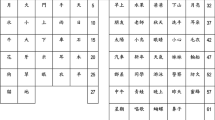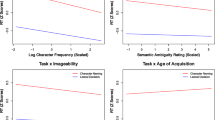Abstract
The purpose of the present study was to investigate developmental differences in lexical processing and sensitivity to the positional information of constituent morphemes with reference to Chinese word-reading ability. One hundred mainland Chinese children (50 s graders and 50 third graders) and 22 high school students were tested with a lexical decision task. The primary school children were also tested for Chinese character reading, morphological awareness, phonological awareness, and non-verbal intelligence. We found that although both primary school children and high school students performed worse in the reversed condition (i.e., the pseudo-words were created by reversing the order of the two characters in real Chinese words) than in the real (i.e., real Chinese compound words) and random conditions (i.e., the pseudo-words were constructed by randomly combining the characters in the reversed condition), the performances of high school students in the reversed condition were closer to their performances in the other two conditions. Correlational analyses conducted on the primary school children revealed that the responses of second- and third-grade children on the lexical decision task were moderately correlated with their Chinese character reading. We also found that, after controlling for age and non-verbal IQ, the reaction time difference between the real and reversed conditions significantly predicted Chinese character reading. The results were discussed by exploring the nature of the lexical decision task, the sensitivity of Chinese children to the positional information of morphemes inside compound words, and the association of such sensitivity with their word-reading performance.

Similar content being viewed by others
References
Bai, C., Cai, S., & Schumacher, P. B. (2011). Reversibility in Chinese word formation influences target identification. Neuroscience Letters, 499, 14–18.
Besner, D., & Johnston, J. (1989). Reading and the mental lexicon: On the uptake of visual information. In W. Marslen-Wilson (Ed.), Lexical representation and process (pp. 291–316). Cambridge, MA: MIT Press.
Betjemann, R. S., & Keenan, J. M. (2008). Phonological and semantic priming in children with reading disability. Child Development, 79, 1086–1102.
Beyersmann, E., Castles, A., & Coltheart, M. (2012). Morphological processing during visual word recognition in developing readers: Evidence from masked priming. The Quarterly Journal of Experimental Psychology, 65, 1306–1326.
Casalis, S., Dusautoir, M., Cole, P., & Ducrot, S. (2009). Morphological effects in children word reading: A priming study in fourth graders. British Journal of Developmental Psychology, 27, 761–766.
Crepaldi, D., Rastle, K., & Davis, C. J. (2010). Morphemes in their place: Evidence for position-specific identification of suffixes. Memory & Cognition, 38, 312–321.
Da, J. (2004). Chinese text computing. http://lingua.mtsu.edu/chinese-computing.
Gagne, C. L., & Spalding, T. L. (2004). Effect of relation availability on the interpretation and access of familiar noun–noun compounds. Brain and Language, 90, 478–486.
Ho, C. S., & Bryant, P. (1997). Phonological skills are important in learning to read Chinese. Development Psychology, 33, 946–951.
Institute of Language Teaching and Research. (1986). A frequency dictionary of modern Chinese. Beijing: Beijing Language Institute Press.
Katz, L., Brancazio, L., Irwin, J., Katz, S., Magnuson, J., & Whalen, D. H. (2012). What lexical decision and naming tell us about reading. Reading and Writing, 25, 1259–1282.
Liu, P. D., Chung, K. K.-H., McBride-Chang, C., & Tong, X. (2010). Holistic vs. analytic processing: Evidence for a different approach to processing of Chinese at the work and character level in Chinese children. Journal of Experimental Child Psychology, 107, 466–478.
Liu, P. D., & McBride-Chang, C. (2010a). Morphological processing of Chinese compounds from a grammatical view. Applied Psycholinguistics, 31, 605–617.
Liu, P. D., & McBride-Chang, C. (2010b). What is morphological awareness? Tapping lexical compounding awareness in Chinese third graders. Journal of Educational Psychology, 102, 62–73.
Lukatela, G., & Turvey, M. T. (1993). Similar attentional, frequency, and associative effects for pseudohomophones and words. Journal of Experimental Psychology: Human Perception and Performance, 19, 166–178.
Marinus, E., & de Jong, P. F. (2008). The use of sublexical clusters in normal and dyslexic readers. Scientific Studies of Reading, 12, 253–280.
McBride-Chang, C., Cho, J.-R., Liu, H., Wagner, R. K., Shu, H., Zhou, A., et al. (2005). Changing models across cultures: Associations of phonological awareness and morphological structure awareness with vocabulary and word recognition in second graders from Beijing, Hong Kong, Korea, and the United States. Journal of Experimental Child Psychology, 92, 140–160.
McBride-Chang, C., Shu, H., Zhou, A., Wat, C. P., & Wagner, R. K. (2003). Morphological awareness uniquely predicts young children’s Chinese character recognition. Journal of Educational Psychology, 95, 743–751.
McCutchen, D., Logan, B., & Biangardi-Orpe, U. (2009). Making meaning: Children’s sensitivity to morphological information during word reading. Reading Research Quarterly, 44, 360–376.
Moret-Tatay, C., & Perea, M. (2011). Do serifs provide an advantage in recognition of written words? Journal of Cognitive Psychology, 23, 619–624.
Nagy, W. E., & Anderson, R. C. (1999). Metalinguistic awareness and literacy acquisition in different languages. In D. Wagner, R. Venezky, & B. Street (Eds.), Literacy: An international handbook (pp. 155–160). Boulder, CO: Westview Press.
Peng, D., Ding, G., Wang, C., Taft, M., & Zhu, X. (1999). Chinese reversible word’s processing: The role of morpheme on word processing. Acta Psychological Sinica, 31, 36–46.
Perfetti, C. A., & Tan, L. H. (1998). The time course of graphic, phonological, and semantic activation in Chinese character identification. Journal of Experimental Psychology. Learning, Memory, and Cognition, 24, 101–118.
Perfetti, C. A., & Zhang, S. (1991). Phonological processing in reading Chinese characters. Journal of Experimental Psychology. Learning, Memory, and Cognition, 17, 633–643.
Raffray, C. N., Pickering, M. J., & Branigan, H. P. (2007). Priming the interpretation of noun–noun combinations. Journal of Memory and Language, 57, 380–395.
Raven, J. C., Court, J. H., & Raven, J. (1996). Standard progressive matrices. Oxford: Oxford Psychologists Press.
Schwanenflugel, J., & Akin, C. E. (1994). Developmental trends in lexical decisions for abstract and concrete words. Reading Research Quarterly, 29, 250–264.
Shelley, S. (2012). Lexical decision with left, right and center visual field presentation: A comparison between dyslexic and regular readers by means of electrophysiological and behavioral measures. Reading and Writing, 25, 1143–1170.
Shu, H., Chen, X., Anderson, R. C., Wu, N., & Xuan, Y. (2003). Properties of school Chinese: Implications for learning to read. Child Development, 74, 27–47.
Shu, H., Peng, H., & McBride-Chang, C. (2008). Phonological awareness in young Chinese children. Developmental Science, 11, 171–181.
Smith, F. (1985). Reading without nonsense (2nd ed.). New York: Teachers College Press.
Taft, M., & Forster, K. I. (1975). Lexical storage and retrieval of prefixed words. Journal of Verbal Learning and Verbal Behavior, 14, 638–647.
Taft, M., Zhu, X., & Peng, D. (1999). Positional specificity of radicals in Chinese character recognition. Journal of Memory and Language, 40, 498–519.
Tan, L. H., Spinks, J. A., Eden, G., Perfetti, C. A., & Siok, W. T. (2005). Reading depends on writing, in Chinese. Proceedings of the National Academy of Sciences of the United States of America, 102, 8781–8785.
Taroyan, N. A., & Nicolson, R. I. (2009). Reading words and pseudowords in dyslexia: ERP and behavioural tests in English-speaking adolescents. International Journal of Psychophysiology, 74, 199–208.
van der Sluis, S., de Jong, P. F., & van der Leij, A. (2004). Inhibition and shifting in children with learning deficits in arithmetic and reading. Journal of Experimental Child Psychology, 87, 239–266.
van Orden, G., & Goldinger, S. D. (1994). Interdependence of form and function in cognitive systems explains perception of printed words. Journal of Experimental Psychology: Human Perception and Performance, 20, 1269–1291.
Wang, S., Dong, X., Ren, Y., & Yang, Y. (2009). The development of semantic priming effect in childhood: An event-related potential study. NeuroReport, 20, 574–578.
Weekes, B. S., Chen, M. J., & Lin, Y.-B. (1998). Differential effects of phonological priming on Chinese character recognition. Reading and Writing, 10, 201–222.
Zhang, J. X., Zhuang, J., Ma, L., Yu, W., Peng, D., & Ding, G. (2004). Semantic processing of Chinese in left inferior prefrontal cortex studied with reversible words. NeuroImage, 23, 975–982.
Zhou, X., & Marslen-Wilson, W. (1994). Words, morphemes and syllables in the Chinese mental lexicon. Language and Cognitive Processes, 9, 393–422.
Zhou, X., Marslen-Wilson, W., Taft, M., & Shu, H. (1999). Morphology, orthography, and phonology in reading Chinese compound words. Language and Cognitive Processes, 14, 525–565.
Acknowledgments
This research was partly supported by the Internal Research Grant of the Hong Kong Institute of Education (Project code: R3318) to Duo Liu. Thanks to all research helpers, the children and their parents for their participation.
Author information
Authors and Affiliations
Corresponding author
Rights and permissions
About this article
Cite this article
Liu, D., Chung, K.K.H., Zhang, Y. et al. Sensitivity to the positional information of morphemes inside Chinese compound words and its relationship with word reading. Read Writ 27, 431–450 (2014). https://doi.org/10.1007/s11145-013-9451-6
Published:
Issue Date:
DOI: https://doi.org/10.1007/s11145-013-9451-6




